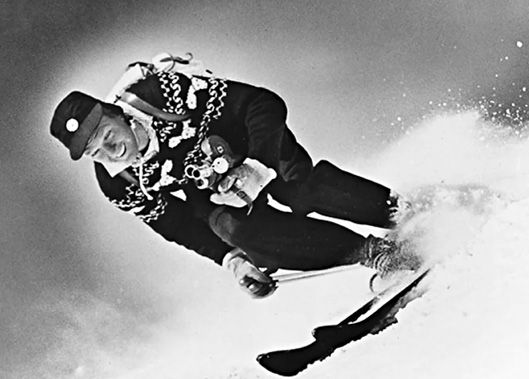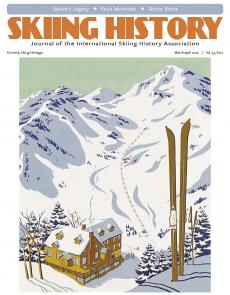SKIING HISTORY
Editor Seth Masia
Managing Editor Greg Ditrinco
Consulting Editor Cindy Hirschfeld
Art Director Edna Baker
Editorial Board
Seth Masia, Chairman
John Allen, Andy Bigford, John Caldwell, Jeremy Davis, Kirby Gilbert, Paul Hooge, Jeff Leich, Bob Soden, Ingrid Wicken
Founding Editors
Morten Lund, Glenn Parkinson
To preserve skiing history and to increase awareness of the sport’s heritage
ISHA Founder
Mason Beekley, 1927–2001
ISHA Board of Directors
Rick Moulton, Chairman
Seth Masia, President
Wini Jones, Vice President
Jeff Blumenfeld, Vice President
John McMurtry, Vice President
Bob Soden (Canada), Treasurer
Einar Sunde, Secretary
Richard Allen, Skip Beitzel, Michael Calderone, Dick Cutler, Ken Hugessen (Canada), David Ingemie, Joe Jay Jalbert, Henri Rivers, Charles Sanders, Christof Thöny (Austria), Ivan Wagner (Switzerland)
Presidential Circle
Christin Cooper, Billy Kidd, Jean-Claude Killy, Bode Miller, Doug Pfeiffer, Penny Pitou, Nancy Greene Raine
Executive Director
Janet White
janet@skiinghistory.org
Membership Services
Laurie Glover
(802) 375-1105
laurie@skiinghistory.org
Corporate Sponsorships
Peter Kirkpatrick
(541) 944-3095
peterk10950@gmail.com
Bimonthly journal and official publication of the International Skiing History Association (ISHA)
Partners: U.S. Ski and Snowboard Hall of Fame | Canadian Ski Museum and Hall of Fame
Alf Engen Ski Museum | North American Snowsports Journalists Association | Swiss Academic Ski Club
Skiing History (USPS No. 16-201, ISSN: 23293659) is published bimonthly by the International Skiing History Association, P.O. Box 1064, Manchester Center, VT 05255.
Periodicals postage paid at Manchester Center, VT and at additional mailing offices. Postmaster: Send address changes to ISHA, P.O. Box 1064, Manchester Center, VT 05255
ISHA is a 501(c)(3) public charity. EIN: 06-1347398
Written permission from the editor is required to reproduce, in any manner, the contents of Skiing History, either in full or in part.
Classics: Speeding into Spring
The temperature rises, the snow corns up and you find yourself asking: How fast is too fast?
I love spring skiing. The toasty temperatures loosen up an old body (as much as that’s possible), the soft, easy-turning snow makes everyone feel like Killy and, let’s face it, a lot of pretty bodies come out from under layers of ski clothes to bask in the mountain sunshine.
But as I was standing behind the safety of a large tree on a recent spring afternoon watching people race by, I didn’t need a radar gun to know that they were all going a lot faster than they did a few years ago.
Warm, late-season weather and soft snow certainly promote this supersonic pace. But there’s another simple reason: The invention of the shaped ski has made it easier and easier to go faster and faster on snow that is groomed so smooth that even a senior citizen can ski faster than racers did in the Harriman Cup Downhill in 1948. I know, because I’m a senior citizen and I raced in the Harriman Cup in 1948. The ski equipment of the 1940s made it impossible to ski at even today’s just-out-cruising speeds.
As more and more skiers get comfortable with today’s equipment, the speeds will get faster, and one of the more common sights on the slopes will be people hiding behind trees or continually looking over their shoulders to dodge other people as they jet down the mountain.
Is there a solution to high-speed skiing? I don’t think so. A ski patroller chasing a high-speed skier down a hill to catch him and take away his lift ticket only compounds the danger—now you have two people skiing too fast on the same run. This raises the basic question: At what speed are we skiing too fast? Is it a mathematical equation that takes the speed of everyone else on the hill and then divides it by the number of skiers per acre and sets an average speed? Then, if you ski a certain percentage above that speed, you pay the consequences. And what resort is going to pay to have a slope sheriff patrol every run?
Recently I skied in great powder snow in Montana. Sixteen inches of goose-feather stuff, and I skied at a comfortable pace for me—I wasn’t skiing fast, but I also wasn’t going slow by anyone’s standards.
I skied by someone who was going a lot slower than I was—and I probably scared the dickens out of her. A hundred yards down the hill, someone raced by me in the deep powder so he could get first tracks. All of us were having a great time in the powder and skiing at much different speeds, so how is some sort of speed standard going to be established?
There was a time when a major destination resort, such as Vail, Colo., or Mammoth Mountain, Calif., only had a few hundred skiers on the hill at one time. I know, because I usually was one of the few hundred.
Now, on President’s Weekend, these megaresorts may hit 20,000 skiers—or more—on their slopes. Because of the large crowds, should everyone ski slower? If they are all forced to slow down, will they ever come back? Is there a moral to this story?
No.
Is there a happy ending? Probably. Should we all have to take a test and then wear a number on our parkas that says this is the maximum speed we can ski or our lift tickets will be pulled? Not yet.
As it has always been, skiing is about freedom. It’s a sport built on the ability to fly down a mountainside—at any speed or in any style that works for you. That hasn’t changed. But skiers and riders now have to be more aware that better gear and better grooming has all of us enjoying that freedom at speeds that would have won the Harriman Cup Downhill in 1948.
Enough of this. I’m going skiing tomorrow—and I might scare myself occasionally. But I’ve purchased a helmet in case someone speeding down the slopes runs into me before the lifts close. 
This column was originally published in the March-April 2007 issue of SKI Magazine.
Table of Contents
WORLD CHAMPIONSHIP ($3,000+)
BerkshireEast/Catamount Mountain Resorts
Gorsuch
Warren and Laurie Miller
Sport Obermeyer
Polartec
CHAMPIONSHIP ($2,000)
Fairbank Group: Bromley, Cranmore, Jiminy Peak
Hickory & Tweed
Rossignol
Snowsports Merchandising Corporation
WORLD CUP ($1,000)
Aspen Skiing Company
Bogner of America
Boyne Resorts
Dale of Norway
Darn Tough Vermont
Dynastar/Lange/Look
Gordini USA Inc/Kombi LTD
Head Wintersports
Intuition Sports
Mammoth Mountain
Marker/Völkl USA
National Ski Areas Association
North Carolina Ski Areas Association
Outdoor Retailer
Ski Area Management
Ski Country Sports
Sports Specialists Ltd
Sugar Mountain
Sun Valley Resort
Vintage Ski World
World Cup Supply
GOLD MEDAL ($700)
Larson's Ski & Sports
Race Place/Beast Tuning Tools
The Ski Company (Rochester NY)
Thule
SILVER MEDAL ($500)
Alta Ski Area
Boden Architecture PLLC
Dalbello Sports
Deer Valley
EcoSign Mountain Resort Planners
Elan
Fera International
Holiday Valley Resort
Hotronic USA/Wintersteiger
Leki
Masterfit Enterprises
McWhorter Driscoll LLC
Metropolitan New York Ski Council
Mt. Bachelor
New Jersey Ski & Snowboard Council
Nils
Russell Mace Vacation Homes
SchoellerTextil
Scott Sports
Seirus Innovations
SeniorsSkiing.com
Ski Utah
Steamboat Ski & Resort Corp
Sundance Mountain Resort
Swiss Academic Ski Club
Tecnica Group USA
Timberline Lodge and Ski Area
Trapp Family Lodge
Western Winter Sports Reps Association
World Pro Ski Tour
Yellowstone Club


